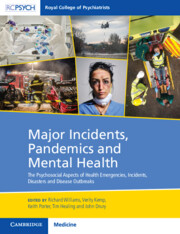 Major Incidents, Pandemics and Mental Health
Major Incidents, Pandemics and Mental Health from Section 3 - The Role of the Public in Emergencies: Survivors, Bystanders, and Volunteers
Published online by Cambridge University Press: 11 January 2024
In the wake of emergencies, incidents, disasters, and disease outbreaks (EIDD), people not directly affected can help those in need to provide urgently needed assistance. As an example, the campaign that followed the Grenfell Tower fire of 2017 evolved into a longer-term movement that sought to address both immediate humanitarian needs and political injustices, The psychological literature is surveyed to identify the drivers of this intergroup solidarity. We highlight the importance of identity processes in informing how communities of people who are not directly affected, or are less affected, respond prosocially to large-scale disasters, and how shared identity can promote community helping. Finally, we discuss which groups are likely to help by drawing attention to nuances that relate to privilege in advantaged groups and intraminority support within disadvantaged groups. We end with a description of how identity processes can be leveraged strategically to elicit intergroup solidarity and mitigate the impacts.
To save this book to your Kindle, first ensure [email protected] is added to your Approved Personal Document E-mail List under your Personal Document Settings on the Manage Your Content and Devices page of your Amazon account. Then enter the ‘name’ part of your Kindle email address below. Find out more about saving to your Kindle.
Note you can select to save to either the @free.kindle.com or @kindle.com variations. ‘@free.kindle.com’ emails are free but can only be saved to your device when it is connected to wi-fi. ‘@kindle.com’ emails can be delivered even when you are not connected to wi-fi, but note that service fees apply.
Find out more about the Kindle Personal Document Service.
To save content items to your account, please confirm that you agree to abide by our usage policies. If this is the first time you use this feature, you will be asked to authorise Cambridge Core to connect with your account. Find out more about saving content to Dropbox.
To save content items to your account, please confirm that you agree to abide by our usage policies. If this is the first time you use this feature, you will be asked to authorise Cambridge Core to connect with your account. Find out more about saving content to Google Drive.